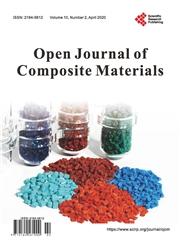The Determination of Interfacial Shear Strength in Short Fiber Reinforced Poly Ethylene Terephthalate by Kelly-Tyson Theory
引用次数: 2
Abstract
The interfacial shear strength value measuring by the modified Kelly-Tyson equation method was studied the measurement accuracy. The measuring accuracy by using the modified Kelly-Tyson equation method is compared to the nano-indentation testing method. The results and an influential factor are described. An error in the modified Kelly-Tyson equation is verified to avoid the incorrect measurement when the interfacial shear strength was measured by the modified Kelly-Tyson equation. To study the different interfacial shear strength behavior, short fiber reinforced PET composites were fabricated. In this study, an advance fabricating technique for short fiber reinforced composite as direct fiber feeding process is conducted to fabricate GF/recycled PET for studying the interfacial shear strength. The result indicates that the modified Kelly-Tyson equation method accurately provides the accurate interfacial shear strength value, if it is conducted with the sample without a horizontally aligned fiber. So the high fiber loading content sample should be avoided to get the more accuracy result. The large horizontally aligned fiber area into specimens extremely resulted in the incorrect measurement of the interfacial shear strength value by the modified Kelly-Tyson equation method. The fiber agglomeration factor and the sensitively horizontally aligned fiber area must be considered its influence on the measuring for improving the equation effectiveness.Kelly-Tyson理论测定短纤维增强聚对苯二甲酸乙二醇酯界面剪切强度
研究了改进的凯利-泰森方程法测量界面抗剪强度值的精度。对改进的凯利-泰森方程法与纳米压痕法的测量精度进行了比较。介绍了试验结果及影响因素。验证了修正Kelly-Tyson方程的误差,避免了修正Kelly-Tyson方程测量界面抗剪强度时的不正确测量。为了研究不同界面剪切强度的性能,制备了短纤维增强PET复合材料。本研究采用先进的短纤维增强复合材料直接进料工艺制备GF/再生PET,研究其界面抗剪强度。结果表明,在不含纤维水平排列的情况下,改进的Kelly-Tyson方程法能准确地给出界面抗剪强度值。因此,为了获得更准确的结果,应避免使用高纤维负载含量的样品。横向排列在试样中的纤维面积较大,极大地导致了修正Kelly-Tyson方程法测量界面抗剪强度值的不正确。为了提高方程的有效性,必须考虑纤维团聚系数和敏感水平排列纤维面积对测量的影响。
本文章由计算机程序翻译,如有差异,请以英文原文为准。
求助全文
约1分钟内获得全文
求助全文

 求助内容:
求助内容: 应助结果提醒方式:
应助结果提醒方式:


